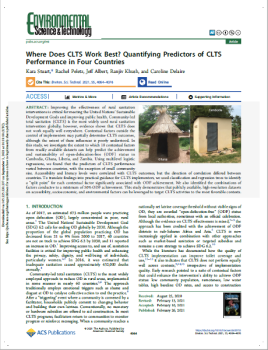Where Does CLTS Work Best? Quantifying Predictors of CLTS Performance in Four Countries
Improving the effectiveness of rural sanitation interventions is critical for meeting the United Nations’ Sustainable Development Goals and improving public health. Community-led total sanitation (CLTS) is the most widely used rural sanitation intervention globally; however, evidence shows that CLTS does not work equally well everywhere. Contextual factors outside the control of implementers may partially determine CLTS outcomes, although the extent of these influences is poorly understood. This paper is from a Water, Sanitation and Hygiene Partnerships and Learning for Sustainability (USAID/WASHPaLS) study investigating the extent to which 18 contextual factors from readily available datasets can help predict the achievement and sustainability of open-defecation-free (ODF) status in Cambodia, Ghana, Liberia, and Zambia. Using multilevel logistic regressions, it was found that the predictors of CLTS performance varied between countries, with the exception of small community size. Accessibility and literacy levels were correlated with CLTS outcomes, but the direction of correlation differed between countries. The study demonstrates that publicly available, high-resolution datasets on accessibility, socioeconomic, and environmental factors can be leveraged to target CLTS activities to the most favorable contexts.
For more information on this study, please refer to the WASHPaLS CLTS Literature Review.
View related resources:
- Community Lead Total Sanitation's Performance Envelope Brief
- Targeting Community-Led Total Sanitation (CLTS) to Favorable Contexts: Factors contributing to the success of CLTS in Ghana
- Targeting Community-Led Total Sanitation (CLTS) to Favorable Contexts: Factors contributing to the success of CLTS in Cambodia
- Targeting Community-Led Total Sanitation (CLTS) to Favorable Contexts: Factors contributing to the success of CLTS in Zambia
- Targeting Community-Led Total Sanitation (CLTS) to Favorable Contexts: Factors contributing to the success of CLTS in Liberia


